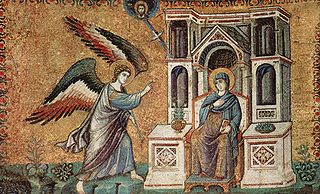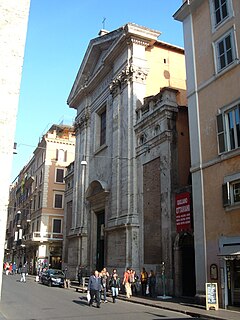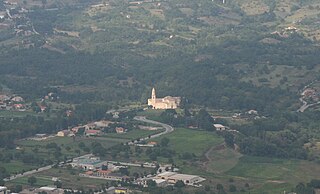
San Francesco d'Assisi a Monte Mario encompass two Roman Catholic churches located in Piazza di Monte Gaudio #8, in Rome, Italy.

San Francesco d'Assisi a Monte Mario encompass two Roman Catholic churches located in Piazza di Monte Gaudio #8, in Rome, Italy.
Presently, the site has a modern church and an older church structures. The older church and an adjacent monastery, built circa 1670, were erected by the Hieronymite order. It was initially titled Sant'Onofrio in Campagna and located in the Borgo Clementino. Located on the entry of the Via Francigena towards central Rome, the church changed the dedication to St Francis of Assisi. It was made a parish church by pope Clement XI. [1]
In 2003, a new church was designed by Anna Claudia Cenciarini. [2] The church has a sculpted frieze. It is presently under the administration of the Scolopi order. [3]

Francis of Assisi, venerated as Saint Francis of Assisi, also known in his ministry as Francesco, was an Italian Catholic friar, deacon, mystic, and preacher. He founded the men's Order of Friars Minor, the women's Order of Saint Clare, the Third Order of Saint Francis and the Custody of the Holy Land. Francis is one of the most venerated religious figures in Christianity.

Perugia is the capital city of both the region of Umbria in central Italy, crossed by the river Tiber, and of the province of Perugia. The city is located about 164 kilometres north of Rome and 148 km southeast of Florence. It covers a high hilltop and part of the valleys around the area. The region of Umbria is bordered by Tuscany, Lazio, and Marche.

Assisi is a town and comune of Italy in the Province of Perugia in the Umbria region, on the western flank of Monte Subasio.

Pietro Cavallini was an Italian painter and mosaic designer working during the late Middle Ages.

Albano Laziale is a comune in the Metropolitan City of Rome, on the Alban Hills, in Latium, central Italy. Rome is 25 kilometres (16 mi) distant. It is bounded by other communes of Castel Gandolfo, Rocca di Papa, Ariccia and Ardea. Located in the Castelli Romani area of Lazio. It is sometimes known simply as Albano.

The Basilica of Saint Francis of Assisi is the mother church of the Roman Catholic Order of Friars Minor Conventual in Assisi, a town in the Umbria region in central Italy, where Saint Francis was born and died. It is a Papal minor basilica and one of the most important places of Christian pilgrimage in Italy. With its accompanying friary, Sacro Convento, the basilica is a distinctive landmark to those approaching Assisi. It has been a UNESCO World Heritage site since 2000.

Brother Sun, Sister Moon is a 1972 film directed by Franco Zeffirelli and starring Graham Faulkner and Judi Bowker. The film is an examination of the life of Saint Francis of Assisi.

There are more than 900 churches in Rome, including some notable Roman Catholic Marian churches. Most, but not all, of these are Roman Catholic.

San Miniato is a town and comune in the province of Pisa, in the region of Tuscany, Italy.

Assisi Cathedral, dedicated to San Rufino is a major church in Assisi, Italy. This stately church in Umbrian Romanesque style was the third church built on the same site to contain the remains of bishop Rufinus of Assisi, martyred in the 3rd century. The construction was started in 1140 to the designs by Giovanni da Gubbio, as attested by the wall inscription visible inside the apse. He may be the same Giovanni who designed the rose-window on the façade of Santa Maria Maggiore in 1163.

The Little Flowers of St. Francis is a florilegium, divided into 53 short chapters, on the life of Saint Francis of Assisi that was composed at the end of the 14th century. The anonymous Italian text, almost certainly by a Tuscan author, is a version of the Latin Actus beati Francisci et sociorum eius, of which the earliest extant manuscript is one of 1390 AD. Luke Wadding ascribes the text to Father Ugolino da Santa Maria, whose name occurs three times in the Actus. Most scholars are now agreed that the author was Ugolino Brunforte.

The Basilica of St. Bartholomew on the Island is a titular minor basilica, located in Rome, Italy. It was founded in 998 by Otto III, Holy Roman Emperor and contains relics of St. Bartholomew the Apostle. It is located on Tiber Island, on the site of the former temple of Aesculapius, which had cleansed the island of its former ill-repute among the Romans and established its reputation as a hospital, continued under Christian auspices today.

The Sacro Convento is a Franciscan friary in Assisi, Umbria, Italy. The friary is connected as part of three buildings to the upper and lower church of the Basilica of San Francesco d'Assisi, which contains the body of Saint Francis. St. Francis wanted to be buried at this location outside of Assisi's city walls, called Hill of Hell, because his master Jesus of Nazareth also was killed like a criminal outside of the city of Jerusalem.
Nicholas Papini was an Italian monk and historian.

Gothic architecture appeared in the prosperous independent city-states of Italy in the 12th century, later than in Northern Europe. Each city developed its own particular variations of the style. Italian architects preferred to keep the traditional construction methods established in the previous centuries; architectural solutions and technical innovations of French Gothic were seldom used. Soaring height was less important than in Northern Europe. Brick rather than stone was the most common building material, and marble was widely used for decoration. In the 15th century, when the Gothic style dominated northern Europe and Italy, the north of the Italian Peninsula became the birthplace of Renaissance architecture.

San Francesco is a Gothic-style, former Roman Catholic church and monastery located on piazza San Francesco in central Lucca, region of Tuscany, Italy. Since its restoration, it is now home to IMT School for Advanced Studies Lucca, a selective graduate and doctoral school.

Gesù e Maria is a Baroque church located on Via del Corso in the Rione Campo Marzio of central Rome, Italy. It faces across the street the similarly Baroque facade of San Giacomo in Augusta.
The entry Church of San Francesco includes churches linked to the devotion to St Francis of Assisi and the Franciscan order. They mainly include churches or monasteries in the Italian peninsula in the following cities/towns and regions:

San Francesco d'Assisi is a Baroque style, Roman Catholic church located on via San Francesco d'Assisi in Turin, region of Piedmont, Italy. The church of San Rocco is on the same street.

The Convent of Saint Francis at Folloni is a Franciscan friary located near Montella in the province of Avellino in southern Italy. The monastery was founded by Saint Francis of Assisi in AD 1221–1222.